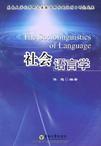社会语言学
出版时间:2010-9 出版社:东南大学出版社 作者:侯旭 页数:287
内容概要
《社会语言学》共分八章,介绍社会语言学主要理论及研究成果。第一章介绍社会语言学兴起的社会、物质、学术背景,分析与相关学科的关系以及分支研究,突出社会语言学边缘学科的特点。第二、第三章介绍社会语言学最重要的研究成果之一——语言变异理论,着重梳理不同研究视角变异研究成果的关系。第四章介绍不同语言在现实生活中接触的状况,并以英语为例,介绍世界英语的理论以及世界英语的几种主要变体。第五章从言语交际研究的最初成果入手,介绍言语交际研究的民族学传统以及语用学成果,并梳理了相邻学科对言语交际的研究视角。第六章从语言、思维与文化的视角介绍哲学、语言学、心理学等学科的研究成果。第七章突出社会语言学理论与实证结合的特点,着重介绍该学科研究方法,并详尽介绍了经典研究实例。第八章重点探讨语言在社会中的运用,包括语言规划及语言教育。 本教材的适用对象:英语专业本科高年级学生、研究生以及其他对语言、社会相关学科感兴趣的读者。
书籍目录
Chapter 1 What is Sociolinguistics1.1 Introduction1.2 A compound term1.3 The rise of soeiolinguisties1.3.1 Time1.3.2 Background1.4 Definitions of sociolinguistics1.5 Sociolinguistics and relevant sciences1.5. l Sociolinguistics and dialectology1.5.2 Sociolinguistics, anthropological and ethnographic linguistics1.5.3 Sociolinguistics and pragmatics1.5.4 Sociolinguistics and socio-semiotics1.6 Branches of sociolinguistics1.6.1 Social dialectology1.6.2 Sociology of language1.6.3 Ethnography of communication1.6.4 Social psychology of language1.6.5 Interactional sociolinguistics1.7 Development of sociolinguistics1.8 Theoretical constructionChapter 2 Language Variation and Varieties2.1 Introduction2.2 Variation and variety2.2.1 Definition of variety2.2.2 Classification of language variation2.3 Dialect2.3.1 Regional/geographical dialect2.3.2 Social dialectChapter 3 More on Language Variation3.1 Introduction3.2 Register3.3 Choice of varieties3.3.1 Code-switching and code-mixing3.3.2 Types of code-switching3.3.3 Motivations of code-switching3.4 Other theories on language variation3.4.1 Speech community3.4.2 Social network3.5 Summary3.6 Variation and social significanceChapter 4 Language Contact4.1 Introduction4.2 Consequences of language contact4.2.1 Language assimilation4.2.2 Language convergence4.3 Language attitude4.3.1 Definition and classification4.3.2 Language loyalty and language competition4.3.3 Measurement of language attitude4.4 Varieties of English4.4. 2 Factors shaping the varieties of English4.4. 3 Examples of varieties of EnglishChapter 5 Speech Communication5.1 Introduction5.2 System of pronouns and address forms——a static perspective5.2.1 T/V5.2.2 Third person pronouns5.2.3 Address terms5.2.4 Social significance of the study5.3 Conversation analysis——a dynamic study5.3.1 Origin and schools5.3.2 Some basic findingsChapter 6 Language, Thought and Culture6.1 Language and thought6.2 Two stands6.3 History of language and thought6.4 Theories on language and thought6.4.1 The Sapir-Whorf hypothesis6.4.2 Prototype theory6.4.3 Basic-level concept6.5 Language and culture6.5.1 Definitions of culture6.5.2 Relationship between language and culture6.5.3 Examples of researches on language and cultureChapter 7 Methodology7.1 Introduction7.2 Quantitative and qualitative study7.2.1 Quantitative research methods7.2.2 Qualitative research methods7.2.3 Summary7.3 Sociolinguistics——the quantitative study of language7.3.1 The procedure7.3.2 Examples of the quantitative studyChapter 8 Applied Issues8.1 Language planning8.1.1 Significance and motivation8.1.2 Types and stages8.1.3 Language planning in modern China8.2 Language education8.2.1 Communicative competence8.2.2 Learners factors8.2.3 Teacher talk, power and solidarity8.2.4 Code-switching and ESL/EFL contextAppendixAppendix 1TerminologyAppendix 2Course SyllabusAppendix 3Evaluation Sheet
章节摘录
In Western history, discussions on the relationship betweenlanguage and the world also reflect what sociolinguistics is concernedwith, and this tradition can be traced back to the ancient Greek timewhen Socrates, Plato and Aristotle lived, though at that time, theirdiscussions mainly focused on what the world was and language wasonly a byproduct of such thinking. By the end of the 18 th century andthe beginning of the 19th century when historical comparative linguisticstudies prevailed, W. Humboldt, the famous German linguist hadpointed out explicitly, "The diversity of languages is not a diversity ofsigns and sounds but a diversity of views of the world. " (Trabant,2000) The task of comparative linguistics should include four parts:language; end of language use; human development and nation, amongwhich at least two were related to sociolinguistics. On the one hand,language is related to nation. It represents a nations spirit andcharacteristics. On the other hand, language is related to thought.Thought determines language and language restricts thought. By the1920s, there had appeared two important linguistic schools in Europeand America and they helped establish basis for the formation anddevelopment of sociolinguistics. The first school isLondon or Functional School represented by B. Malinowsky and J.Firth. The second school is North American Anthropological Linguisticsrepresented by F. Boas and E. Sapir. As time goes by, both schoolshave developed a close relation between sociolinguistics.
图书封面
评论、评分、阅读与下载
